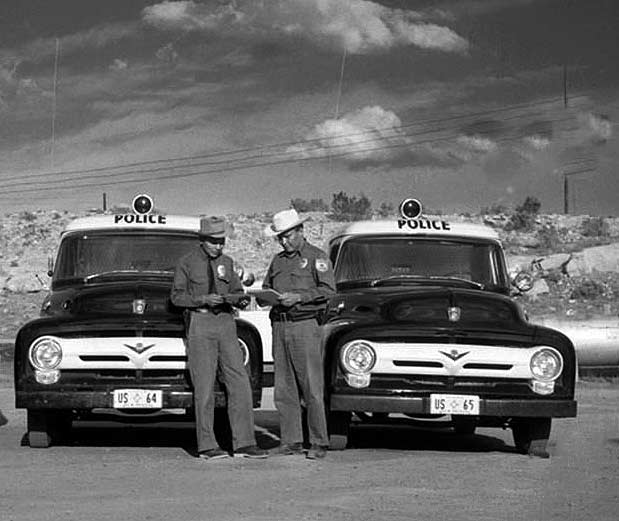
50 Years Ago: Couple drives from Utah with deceased son

Historical photo of Navajo Nation Police.
It was, to say the least, a first for the Gallup Police Department when a Navajo couple drove up to police headquarters on July 30, 1967, and told them the body of their nine-year-old son was in the back seat of their car.
It turned out that the family had been in Perry, Utah, two days before picking cherries when their son had an accident. He was on a ladder that was blown over by the wind, throwing him to the ground.
When the parents went up to the boy, they said, he told them he was all right but started complaining that he was feeling ill a few hours later so they decided to cut their cherry picking short and return to Gallup where they lived.
A few hours into their journey, they stopped to eat at a restaurant near Salt Lake City and discovered that their son, who they thought had fallen asleep in the back seat, had died.
They discussed the situation — should they notify officials in Salt Lake City or keep going to Gallup where they would be able to go ahead with burial services?
Their decision was to put the boy in the back seat and continue going to Gallup where nearly 20 hours later they drove up to the police station and reported the news to authorities.
The police department arranged for the boy to be transported to the Public Health Service hospital where doctors there officially pronounced him to be deceased.
Although there were laws prohibiting the transportation of a dead body over state lines, the police department decided not to file any charges and allowed the family to go home and mourn the passing of their son.
Some 200 new teachers arrived at Fort Wingate on July 29 to begin two weeks of special training on how to adapt to working at Navajo boarding schools. The teachers were from all over the country and this marked the first time for almost all of them that they would be working with Native children.
The instruction was supervised by Anna Miles, an education specialist who worked for the BIA.
“The purpose is to orient the new teachers to the unique problems we face in education on the Navajo Reservation,” she said.
There will be classes on Navajo culture and history as well as a brief lesson on Navajo politics. The government is even planning to bring students from Rock Point and another group from the Chuska Boarding School to give teachers a chance to work with young Navajo students while being supervised by more experienced teachers.
Navajo Tribal Chairman Raymond Nakai was also scheduled to welcome them to the reservation and give them some insight into what life is like on the Navajo Reservation and to convince them that the students that they would be working with aren’t like the young Indians they may have seen in movies or on television.
There were no Natives among the new teachers and more than 80 percent of them were young, single women. Most had an extensive religious background because the BIA in recent years had been doing a lot of recruiting at religious colleges, finding students there to be more receptive to living in remote areas where they may not be able to get to a big city for weeks at a time.
“Many of these teachers,” said Miles, “will experience a major culture shock and we’re hoping that the information we provide them will make them feel more comfortable about living at a boarding school.”
In other news, the officials at the Gallup Indian Center were promoting an event that was going to take place in early August. They were going to chapters in McKinley and Apache counties urging tribal members to attend if they come to Gallup during the first two weeks in August.
The center staff was excited about plans to present a “pageant” centered around the Long Walk, which would be shown every night beginning at 7 p.m.
Using Navajo students from Church Rock and other Navajo communities, the center was going to tell the history of the Long Walk, using stories that had been passed down from Navajos who actually took part in the Long Walk.
In many cases, the students would be acting out events along the Long Walk that their ancestors took part in.
And finally, the new Miss Indian America would be making her first official visit at the Gallup Inter-tribal Indian Ceremonial.
Sarah Ann Johnson, a Navajo from Window Rock, beat out 40 other contestants from other Indian tribes at the event held in early August in Sheridan, Wyoming. She was Miss Navajo in 1966 and was working for the tribe’s land investigation department when she was chosen for the national title.
She was the third Miss Navajo to win the Miss Indian America competition. As Miss Navajo, she had the opportunity to travel extensively and meet then-President Lyndon B. Johnson, as well as former President Dwight David Eisenhower.
She would be doing a lot of traveling as Miss Indian America so it’s uncertain whether she would continue working for the tribe.
One of the runners-up in the competition was Bernita Puhufyestewa, the contestant from Second Mesa on the Hopi Reservation.
To read the full article, pick up your copy of the Navajo Times at your nearest newsstand Thursday mornings!
Are you a digital subscriber? Read the most recent three weeks of stories by logging in to your online account.







 Highway 264,
Highway 264, I-40, WB @ Winslow
I-40, WB @ Winslow